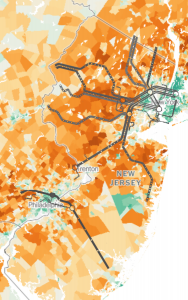New Jersey Future Blog
Helping NJ Drive Less: The Need to Dedicate Funding to Transit and Safe Streets
January 31st, 2023 by Kimberley Irby

The New York Times (NYT) Climate Impact Map of New Jersey overlaid as closely as possible with NJ Transit lines, emphasizing the NYT data which shows how people living in denser areas, where there is typically less driving, are responsible for fewer carbon emissions.
Electric vehicles are great, but they won’t reduce greenhouse gas (GHG) emissions in the transportation sector fast enough, nor will they do anything to alleviate congestion. This past October, the United Nations published the Emissions Gap Report 2022, declaring that an important action for the transportation sector is to “integrate land use and transportation planning to prioritize public transit over private automobiles.” As we confront climate change alongside congestion, road fatalities, and high gas prices, it is imperative that New Jersey not only facilitates increasing electric vehicle adoption, but focuses on the range of solutions that encourage people to drive less.
Though record-high gas prices last year reminded us of the expense of vehicle ownership, the costs of car dependency are more than economic. Traffic deaths are on the rise, revealing the human cost of our dangerous streets and roads. People waste precious hours of their lives idling in traffic, which emits pollution that disproportionately harms low-income and Black and Brown communities too often encroached upon or divided by urban highways. Meanwhile, there are many benefits of transit, biking, and walking, including improvements in affordability and equity, health and safety, climate and economy, and increasing leisure time.
State and federal transit agencies, nonprofits, and private partners are aiming to reduce our dependence on private vehicles, but there is much more to be done. Alternatives to driving mostly include active transportation (e.g., walking, biking, rolling) and public transit (e.g., bus, rail, light rail). We must ensure more money and planning goes towards those activities. This would mean sufficient capital and operating funds to ensure public transit is efficient and reliable and active transportation routes are safe and accessible.
We can also address the issue of car-dependency through the lens of land use: building destinations closer together, ensuring safe connectivity between transit stations, and creating safe streets. What is known as “Complete Streets” design and implementation is crucial to improve safety and accessibility for all active transportation modes. Overall, there is a need to be more intentional about creating places and investing in infrastructure that support both driving shorter distances and using other modes of getting around.
NJ Transit, in particular, is a vital service and tool in helping New Jerseyans drive less. It is the nation’s largest statewide public transportation system of buses, rail, and light rail, and it serves nearly one million riders per day. Despite its potential to get people out of cars, there is currently no reliable, dedicated source of funding for the system’s essential operating needs. For years, NJ Transit has relied on rider fares and funding diverted from various sources, such as the state’s Clean Energy Fund, to sustain itself. Since the onset of the pandemic, NJ Transit has utilized federal relief to plug budget gaps, but the agency faces a fiscal cliff when aid money runs out in 2026. With the push for more electric vehicles on the road, gas tax revenue is expected to shrink, reinforcing the imperative to find a steady source of funding elsewhere.
NJ Transit requires capital funds to maintain a state of good repair, upgrade the existing system, and become more environmentally sustainable, by, for example, acquiring electric buses. Operating funds are just as vital, allowing the agency to provide reliable, affordable service. The first draft of next year’s state budget will be issued in February, and now more than ever, we need our legislators to commit to adequate funding for NJ Transit operations, both in the short- and long-term, that does not detract from the agency’s capital budget or the state’s Clean Energy Fund. Strengthening NJ Transit helps all New Jerseyans when it comes to transportation: it directly supports those who do not want to rely on or are not able to afford private vehicles, and indirectly supports drivers by reducing congestion.
We all benefit from living and working in places where we have the flexibility to move between critical places without relying on a car, and we should demand relevant solutions from our elected leaders. Whether you walk, bike, ride public transit, or simply want reduced congestion, prioritizing funding for strategies that can ultimately help reduce car dependency improves all of our commutes and air quality. As we strive to reduce our greenhouse gas emissions, especially from transportation, and to be a state that is rich with various mobility options, we must prioritize center-based design, implement safe street design, and provide operating funds for public transit. Doing so will not only help us mitigate the climate crisis, but also will enable better placemaking to improve the lives of all New Jerseyans.
Related Posts
Tags: active transportation, Complete Streets, electric vehicles, emissions, public transit, public transportation, safe streets, Transit, Transportation, transportation funding
















